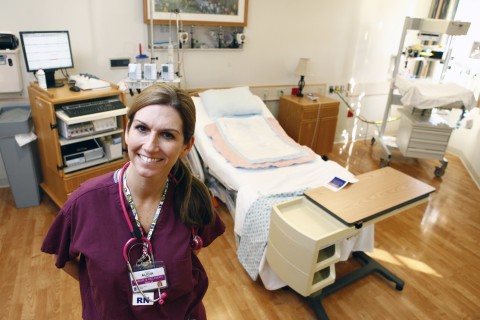Last menstrual period date:
Well, first, let’s hope you make it to the hospital rather than onto the 6 o’clock news as a new mama who delivered her baby with the heroic help of her birth partner in the back of the car! While some labors are extremely quick when pregnant, pregnancy delivery for most labors will take several hours; this gives you plenty of time to arrive and get settled at the hospital.

Your Arrival
Hopefully you were able to tour the hospital during your second or third trimester. You’ll need to navigate your way once again to pregnancy delivery and labor. Many hospitals have safeguards put into place, and you’ll need to be buzzed into this area of the hospital. At the reception desk, you’ll be handed a clipboard with forms. They’ll ask for all the usual information, such as your address, insurance information, OB, and Pediatrician. They’ll also ask your preference regarding if the baby should always leave your room accompanied. Many hospitals no longer have maternity wards; most now advocate rooming, which dictates that the baby stays with the mother. However, sometimes doctors or nurses may remove the baby for testing; the hospital will want to know if you or your birth partner want to accompany the baby when he or she leaves the room. Some hospitals may also ask if you have a living will; if you do, you should bring a copy with you.
If this is your first time pregnant, delivery of a baby is left to the pros. It’s a good thing to keep in mind that this is what the doctors and nurses in this wing do every day: every hour of every day. Your contractions may be growing stronger, and you may be leaning onto the reception desk for dear life, but this is normal. Although you may feel as though your world is spinning, birth happens all the time. If you need something, don’t be afraid to ask for it—politely.
After check-in is complete, you’ll receive a hospital bracelet. This hospital bracelet will be coded to your newborn, and in many hospitals if the baby is removed while wearing the bracelet an alarm will sound.
Your Labor and Delivery Room
Most hospitals offer private labor and delivery rooms. Your room should have a bed and small bathroom. It may also have an in-room station to check the baby immediately after birth. Beside the bed will be various monitoring devices. Some hospitals provide TVs and radios or docking stations. Additional birth equipment may be provided such as birthing balls or birthing stools to aid in the delivery of your baby.
In most hospitals a labor and pregnancy delivery nurse will be assigned to your room. She’ll stay with you for the remainder of your labor, unless it runs long and another shift comes on. There will likely be a dry erase board in your room and she’ll write her name on it. One of the first things she’ll do is hook you up to an IV. She’ll check in every so often to take your blood pressure and monitor your dilation and effacement progress.
After you’re settled in, your OB will arrive, review your birth plan, and discuss whether you’d like an epidural.
Your Recovery Room
After giving birth, you’ll be moved to a recovery room. Mothers who deliver vaginally usually remain in the hospital for three days, although if the birth was complicated, it may be as many as five or more. Mothers who give birth by C-section typically remain for five days to ensure that the wound is healing well and no other complications present themselves. Your recovery room should have a small convertible bed for your birth partner.
Remember: the labor and delivery nurses and OBs deliver babies every day. They know what they’re doing! Be polite but firm in your requests; if you want to hold your baby immediately after birth, make sure that the staff knows. Having multiple copies of your birth plan available is a good idea to clearly communicate your wishes without having to constantly repeat them.
My content



